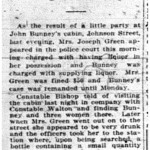Learn more about the justice system by looking at documents in the digital archive
Supreme Court Trials in Victoria were held at the Provincial Courthouse in Bastion Square.[1] Before 1910, there was no separate Court of Appeal. Members of the Supreme Court of B.C. were also responsible for reviewing legal convictions-meaning that judges could sit on panels reviewing their own decisions and dissuade other judges from overturning them.
![Mr. Justice Archer Martin. Source: Image Courtesy of Royal BC Museum, BC Archives - Call Number: A-02290 See BC Archives Date: [1898]](http://acitygoestowar.ca/wp-content/uploads/2013/08/a_02290-205x300.gif)
Mr. Justice Archer Martin.
Source: Image Courtesy of Royal BC Museum, BC Archives – Call Number: A-02290
See BC ArchivesDate: [1898]
![Chief Justice Gordon Hunter. Source: Image Courtesy of Royal BC Museum, BC Archives - Call Number: A-02236 See BC Archives Date: [ca. 1910]](http://acitygoestowar.ca/wp-content/uploads/2013/08/a_02236-212x300.gif)
Chief Justice Gordon Hunter.
Source: Image Courtesy of Royal BC Museum, BC Archives – Call Number: A-02236
See BC Archives Date: [ca. 1910]
Ironically, the Court of Appeal was established not simply to remedy this unjust protocol, but also to solve a personal dispute between Chief Justice Gordon Hunter and Justice Archer Martin. Men of conflicting personalities, their quarrels escalated when Premier Richard McBride allowed Hunter to assign the judicial duties of all other members of the court, a power that particularly irked Martin. The press widely reported on an incident in which Martin insisted on coming to a series of appeal hearings, despite being assigned otherwise, and argued with the three judges already present that he was legally entitled to be on that panel. Hunter and Martin’s feud continued without either being dismissed, because the federal government and the provincial government had not yet decided who had authority over the court. By 1909, the situation had become intolerable. The federal and provincial authorities agreed to establish a Court of Appeal and send Martin there, never to directly challenge Hunter again.[2]

A description of an alcohol possession case in Police Court during the prohibition years.
Source: Victoria Daily Times.Date: January 16 1920, page 9.
Many trivial local crimes, however, never proceeded farther than Victoria’s Police Court. The less serious infractions heard daily by the presiding Magistrates provided lively news for the local papers, particularly during the Prohibition years.
The practice of law was theoretically open to all British subjects, “of full age and good repute.”[3] In 1912, however, when Helen French applied for a license to the Law Society of British Columbia, the BC Court of Appeal decided that the definition of persons in the Interpretation Act, which included women, did not apply to the Legal Profession Act. Attorney General William Bowser, although personally opposed to women’s rights, deferred to public pressure and submitted An Act to Remove the Disability of Women so far as it related to the Study and Practice of Law. French became a lawyer, and two more women followed in 1916 and 1918. Interestingly, although most feminists in this period were “maternal feminists,” arguing the women’s role as mothers gave them a special duty to ensure morality in public life, many female lawyers may have been “liberal feminists,” advocating for equal rights. Throughout the 1920s, however, it was socially expected that women would cease to practice upon having children. Whether out of deference to this view, or out of personal preference, many women left the profession when they decided to have children. Other women chose to remain single or to remain childless, and continued to practice law.[4]
The Law Society faced little public pressure to admit citizens of Asian descent into the legal profession, however. On October 7, 1918, the Law Society ruled that “orientals” could not practice law until they were legally franchised, and rejected the application of law student Gordon Won Cumyow. [5]
[1] Danda Humphreys, Government Street: Victoria’s Heritage Mile (Victoria: Heritage House Publishing, 2012), 23-25.
[2] Hamar Foster and John McLaren, “For the Better Administration of Justice: The Court of Appeal for British Columbia, 1910-2010,” in BC Studies 162 (Summer 2009): 7-14.
[3] The Legal Professions Act, 61 Vict. (1897), c. 24, section 37(3), quoted in Joan Brockman, “Exclusionary Tactics: The History of Women and Visible Minorities in the Legal Profession in British Columbia,” in Essays in the History of Canadian Law Volume 6, ed. David H. Flaherty, John McLaren, and Hamar Foster (Toronto: University of Toronto Press, 1995), 508-512, 521.
[4] Joan Brockman, “Exclusionary Tactics,” 526-531.
[5] Joan Brockman, “Exclusionary Tactics, 508-512, 521.
Archives
Victoria Police Archives
The Maritime Museum
Victoria City Archives
British Columbia Archives
Bibliography
Brockman, Joan. “Exclusionary Tactics: The History of Women and Visible Minorities in the Legal Profession in British Columbia.” In Essays in the History of Canadian Law Volume 6, edited by David H. Flaherty, John McLaren, and Hamar Foster, 508-562. Toronto: University of Toronto Press, 1995.
Foster, Hamar and John McLaren, “For the Better Administration of Justice: The Court of Appeal for British Columbia, 1910-2010.” BC Studies 162 (Summer 2009): 5-24.
Humphreys, Danda. Government Street: Victoria’s Heritage Mile. Victoria: Heritage House Publishing, 2012.